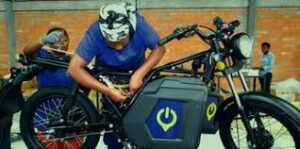African electric motorcycle and battery-swapping company Spiro raised $100 million—the largest investment in African two-wheel electric mobility—with $75 million from The Fund for Export Development in Africa (FEDA), the development impact investment arm of African Export-Import Bank (Afreximbank).
Founded in 2022, Spiro operates battery-swapping infrastructure across six African nations (Kenya, Uganda, Rwanda, Nigeria, Benin, Togo) with pilots in Tanzania and Cameroon. The company projects surpassing 100,000 deployed vehicles by the end of 2025, positioning among global battery-swapping leaders.
The round brings total capital raised to over $280 million including previous investments from Equitane and Société Générale. CEO Kaushik Burman cited rider migration from internal combustion motorcycles to Spiro’s ecosystem based on lower operating costs and higher profitability versus gas-powered vehicles.
FEDA’s $75 million investment (75% of round) represents development finance backing over pure venture capital—indicating Spiro’s positioning as an infrastructure project serving policy objectives beyond commercial returns.
Professor Benedict Oramah, Afreximbank President and FEDA Chairman, framed investment around industrialization and trade: “We are laying the foundation for a new era of intra-African trade and industrialization, driving local vehicle manufacturing, strengthening regional integration, and facilitating enhanced trade flows. This investment will help generate skilled employment opportunities and reduce Africa’s dependence on imported second-hand vehicles.”
The emphasis on local manufacturing, employment generation, and import substitution reflects African governments’ priorities around industrial policy and foreign exchange conservation. DFI backing provides advantages beyond capital: patient capital tolerating longer payback periods, government relationship facilitation, and reputational validation with risk-averse institutional customers.
However, DFI capital often carries restrictions on deployment (must benefit target countries/populations), reporting requirements (impact metrics beyond financial returns), and slower decision-making versus commercial investors. The 75% DFI composition suggests limited pure venture capital interest at current valuations—either market views risk/return unfavorably or company prioritizes strategic over financial investors.
Spiro’s battery-swapping model addresses range anxiety and charging time constraints limiting electric vehicle adoption. Riders exchange depleted batteries for charged units at swap stations in minutes versus hours charging onboard batteries.
The model creates advantages for commercial riders (motorcycle taxis, delivery drivers) prioritizing vehicle uptime over ownership economics. Swapping enables continuous operation without charging downtime, increasing daily earning potential justifying subscription fees.
However, battery swapping requires substantial infrastructure capital. Each swap station needs multiple charged batteries, charging equipment, real estate, and staffing. Network effects matter—stations must achieve density where riders confidently travel knowing swap stations exist throughout the operating area.
Spiro’s six-country footprint creates operational complexity. Unlike software scaling globally from a single codebase, battery-swapping requires physical infrastructure in each market with different: electrical grid reliability (affecting charging costs), real estate costs (affecting station economics), regulatory frameworks (affecting permitting), and competitive dynamics (affecting rider acquisition costs).
The company has not disclosed profitability status or path. Key metrics determining sustainability include:
Vehicle deployment capital efficiency: Cost to manufacture/acquire motorcycles, ship to Africa, and place with riders.
Battery swap station utilization: Swaps per station per day determining revenue against fixed costs.
Battery life cycles: Number of charge cycles before replacement determining per-swap depreciation.
Rider retention: Monthly subscription revenue continuity versus acquisition costs.
Energy costs: Charging expenses particularly in markets with unreliable/expensive grid power.
African motorcycle taxi markets exhibit challenging economics. Riders earn $5-15 daily in most markets. If Spiro charges $2-3 daily for battery swaps (competitive with fuel costs), gross margin must cover vehicle subsidies, battery depreciation, station operations, and corporate overhead.
Traditional venture-backed electric vehicle companies struggle achieving profitability due to hardware costs and infrastructure capital intensity. Spiro’s DFI backing suggests lower return expectations than commercial venture capital, potentially supporting longer path to profitability acceptable to development finance but not traditional VCs.
Competitive Landscape and Market Sizing
The African two-wheel vehicle market is substantial—millions of motorcycles operate across the continent for personal transport and commercial use (motorcycle taxis known as boda boda, okada, or similar local terms).
Most African motorcycles are Chinese-manufactured internal combustion engines sold through informal distribution networks. Prices range $500-1,500 depending on specifications and market. These vehicles use gasoline at $1-2 per liter with riders consuming 2-5 liters daily depending on usage intensity.
Spiro competes against: established internal combustion motorcycle ecosystem with known economics and ubiquitous refueling, emerging electric motorcycle manufacturers (Arc Ride, Roam, Ampersand) pursuing similar African markets, and potential future competition from Chinese EV manufacturers entering African distribution.
The 100,000 deployed vehicles target by end-2025 represents a small fraction of the total African motorcycle fleet (estimated tens of millions). Market penetration depends on whether Spiro demonstrates superior total cost of ownership, convincing riders to switch from established ecosystems.
Oramah emphasized “local vehicle manufacturing” as an investment rationale. However, Spiro’s operational model and manufacturing location remain undisclosed.
Most African electric vehicle startups assemble vehicles from imported components rather than manufacturing from raw materials. “Assembly” versus “manufacturing” distinction matters for employment generation, value capture, and import substitution claims.
If Spiro imports complete vehicles or major components (batteries, motors, controllers) from China and performs final assembly in Africa, local value-add and employment creation may be modest. True manufacturing creating motors, battery cells, and electronic components would deliver greater industrialization impact but requires substantially larger capital and technical capabilities.
The claims warrant scrutiny because DFI investments often emphasize local content and employment impact. If operational reality differs from stated objectives, subsequent funding rounds or impact audits may reveal gaps between investment thesis and execution.
Operating across six countries with pilots in two additional markets creates regulatory complexity. Each jurisdiction requires: vehicle type approval, battery safety certification, electrical installation permits, business licenses, and potentially special EV incentives or mandates.
However, multi-country presence also provides regulatory arbitrage opportunities. If one market introduces unfavorable regulations (increased taxes, reduced subsidies), Spiro can prioritize other jurisdictions. This geographic diversification differs from single-country competitors vulnerable to regulatory changes in home market.
The East African focus (Kenya, Uganda, Rwanda, Tanzania) benefits from regional integration efforts. East African Community harmonization of standards and trade facilitation could reduce cross-border operational friction compared to West African markets (Nigeria, Benin, Togo) operating under different regulatory frameworks.
Investment Thesis Validation Requirements
For investors at $100 million round size (implied valuation undisclosed), key metrics over next 12-24 months include:
Vehicle deployment pace: Achieving 100,000 deployed vehicles by end-2025 from current undisclosed base.
Station utilization: Swaps per station per day indicating rider adoption and network density sufficiency.
Rider retention: Churn rates and lifetime value determining sustainability versus acquisition costs.
Unit economics: Contribution margin per vehicle after direct costs indicating path to profitability.
Geographic expansion: Successful pilot conversion in Tanzania and Cameroon to commercial operations.
Local manufacturing: Verification of assembly/manufacturing claims and local content percentages.
The development finance backing suggests patient capital tolerating longer payback periods than traditional venture investors. However, even DFIs require eventual return on investment. Spiro must demonstrate either path to profitability or strategic value justifying acquisition by larger








